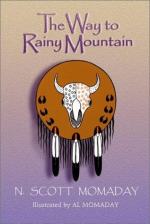|
This section contains 4,252 words (approx. 15 pages at 300 words per page) |

|
SOURCE: "N. Scott Momaday: Beyond Rainy Mountain," in American Indian Culture and Research Journal, Vol. 3, No. 1, 1979, pp. 57-67.
In the following essay, Berner analyzes the themes and organization of The Way to Rainy Mountain.
Defying generic description, The Way to Rainy Mountain is an abbreviated history of the Kiowa people, a reworking of Kiowa folklore, a mixture of legend, historical fact, and autobiography. More precisely, it may be considered a kind of prose poem derived from traditional materials which are perceived personally, an exercise in self-definition made possible by a definition of the Kiowa experience. Ultimately the book's subject must be understood as language itself—its origins, its power, its inevitable collapse, and finally, its re-birth as art.
As Emerson says in Nature, every word was originally a poem, arising out of a need for some means of referring to a concrete phenomenon; for example, he says, supercilious...
|
This section contains 4,252 words (approx. 15 pages at 300 words per page) |

|


